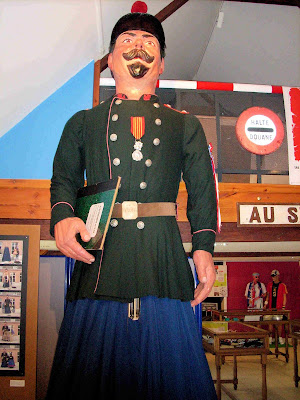“Are you a customs officer or a smuggler?” That’s the question we were asked when we walked into the ‘Musée de la vie frontalière’ (Life on the border) in the tiny village of Godewaersvelde in French Flanders.
After we had paid the income fee, the lady behind the desk handed us each a questionnaire which would determine whether we were rather a ‘douanier’ or a ‘fraudeur’. On the left page Henri, the ‘douanier’ had written down 10 questions regarding his job, the tools and arms he used. On the right page Albert, the ‘fraudeur’, had done the same about his illegal occupation. The answers to the questions were to be found in the two halls of the museum.
The cover page of the questionnaire
We thought it would be just a piece of cake to fill out the form, but we were wrong. The questions looked easy enough but it took the four of us, working as a team, well over an hour to find the correct answers. We had a lot of fun though, and for a while felt like little schoolchildren again who were out on their yearly school trip.
Just to test your knowledge about customs and smugglers here is one of Henri’s questions:
What's the 'Brunel line'?
A: a hook attached to a long rope - B: a fishing rod - C: the border between France and Belgium.
And here’s one of Albert’s:
Why is the end of the smugglers' walking stick painted white?
A: it's a kind of 'white flag' to indicate that he's ready to surrender to the customs - B: because it's old and used - C: to incite the customs' dog to bit the end of the stick.
Do you know the right answers? I’ll post them tomorrow. In the meantime, why don't you take a guess!?
The museum also hosts the ‘géants’ (giants) representing Henri and his dog Dick. On special occasions, such as Mardi Gras, village carnivals and fairs, etc. the giants are dressed up and paraded through the village streets. Henri is approximately 4 metres tall and weighs over 60 kilos. He’s made of wood, paper mache and cloth. He’s carried by one strong man who is inside the wooden frame.
The giant representing 'Henri le Douanier'
The giant representing the smuggler's dog Tom, carrying the two 'blattes' on its back
(to be continued)
____



2 comments:
I'll bite. The Brunel line might be the border between Belgium and France, and I have no clue to the second one, but I'll guess that it's so the dog will bite it. Seems unlikely, but I don't think surrendering is the smuggler's intention.
Carolyn, For now, I'm not going to tell you how you did, but thanks a lot for taking the little quiz. Let's see if there are some more readers who want to take a guess. The answers will be in tomorrow's post! ;)
Post a Comment